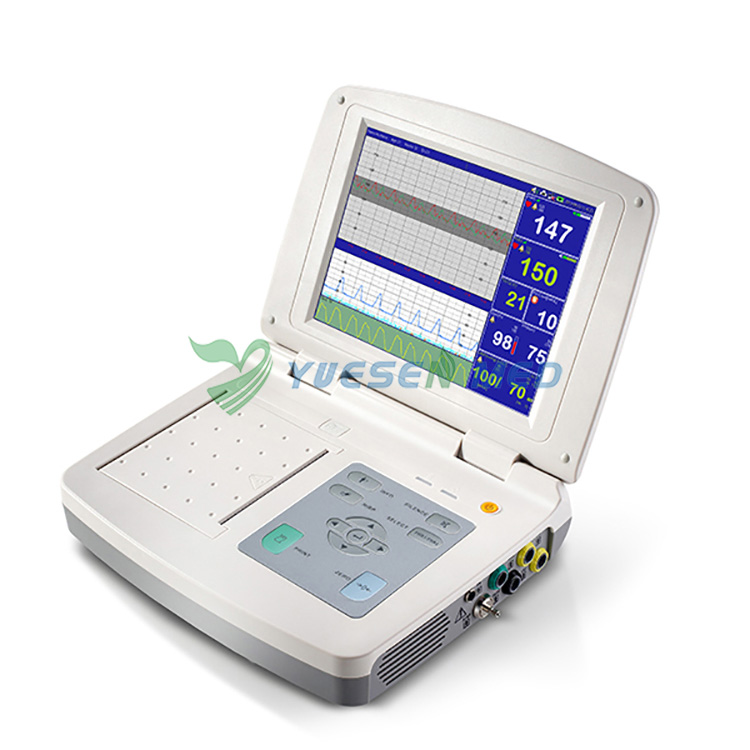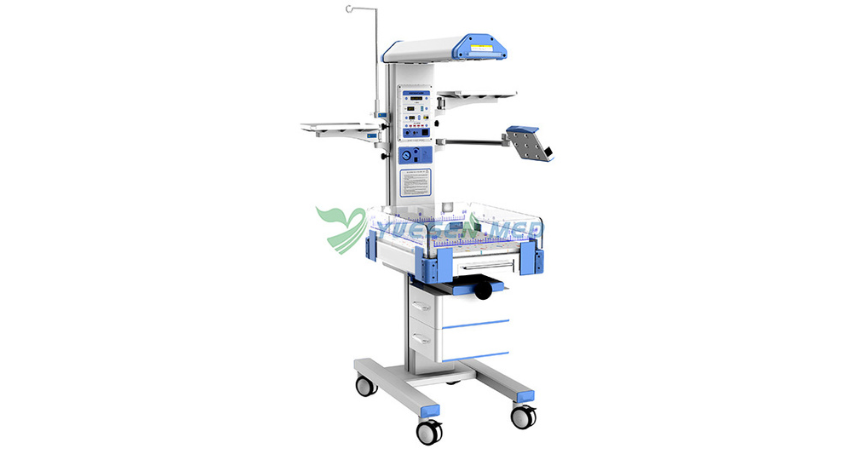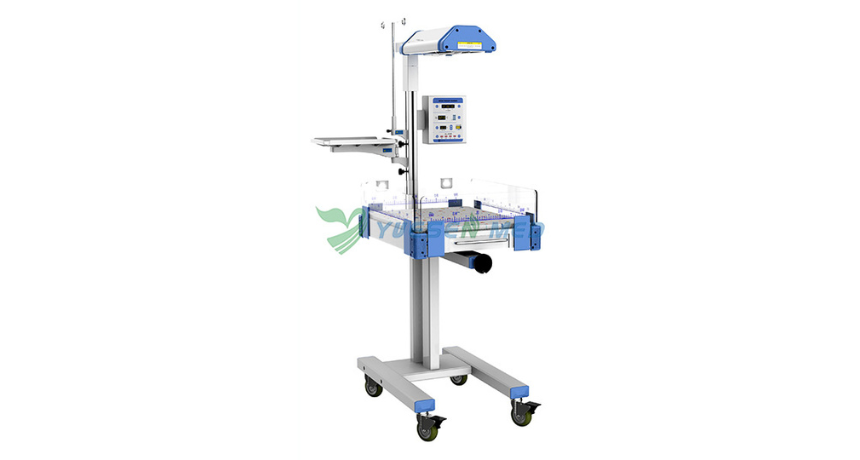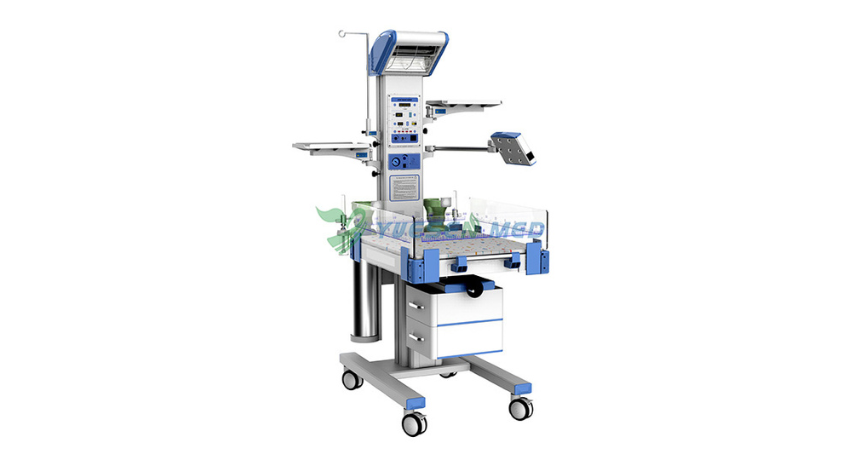Hot Products
YSX500D 50kW DR system set up and put into service in Cambodia.
YSENMED YSX500D 50kW digital x-ray system has been successfully set up and put into service in a hospital in Cambodia.
YSX056-PE serving as a vehicle-mounted x-ray in the Philippines
YSX056-PE 5.6kW portable x-ray unit has been adapted to fit on a truck, to provide mobile x-ray examination service for remote communities in the Philippines.
X Ray Machine To Zimbabwe
x ray machine, 50KW x ray machine
Microscope To Malawi
Achromatic objectives: 4X、10X、40X(S), 100X(S、Oil) Wide field eyepiece: WF10X(WF16X for option) Eyepiece head: Sliding binocular head inclined at 45° Stage: Double layer mechanical stage size 140X140mm, moving range 75X45mm Focusing: Coaxial coarse and
Portable and Powerful: How a 10.4-Inch Fetal Monitor Keeps Moms and Babies Safe
Views : 1229
Update time : 2024-08-16 10:59:00
When it comes to pregnancy, every mom wants to ensure that her baby is safe and healthy. Enter the 10.4-inch fetal monitor—a game-changer in prenatal care. This nifty device not only provides critical information about your baby's well-being but does so in a way that's portable and user-friendly. So, let's dive into how this technology works and why it's becoming a must-have for expectant mothers.

What is a Fetal Monitor?
A fetal monitor is a device that tracks a baby's heart rate and the mother's contractions during pregnancy. Think of it as a lifeline connecting you to your little one, providing real-time data that can ease your worries and help you prepare for childbirth.
Why Choose a 10.4-Inch Fetal Monitor?
Size Matters
The 10.4-inch size strikes a perfect balance between portability and usability. It's big enough to provide a clear display of vital information, yet compact enough to fit in a diaper bag or bedside table. Imagine being able to monitor your baby's health wherever you go—whether you're at home, visiting friends, or even on vacation.
Easy to Use
One of the best features of a 10.4-inch fetal monitor is its user-friendly interface. Most models come with touchscreens and intuitive controls, making it easy for anyone to operate. You don't need to be a tech whiz to understand what's happening with your baby!
Key Features of a 10.4-Inch Fetal Monitor
Real-Time Heart Rate Monitoring
The primary function of a fetal monitor is to track the baby's heart rate. A healthy fetal heart rate typically ranges from 120 to 160 beats per minute. Monitoring this can give you peace of mind, knowing that your baby is thriving.
Contraction Tracking
For expectant moms, knowing when contractions start and how long they last is crucial as you approach labor. A good fetal monitor will provide accurate readings, helping you recognize patterns and determine when it's time to head to the hospital.
Portability
Unlike traditional monitors that are often bulky and stationary, a 10.4-inch fetal monitor is designed for mobility. Whether you're lounging on the couch or taking a stroll in the park, you can easily bring it along. It's like having your own mini-hospital right at your fingertips!
Battery Life
Most modern fetal monitors come with impressive battery life, allowing you to use them for extended periods without needing to recharge. This is particularly handy for those long nights when you just can't sleep and want to check in on your baby.
Benefits of Using a Fetal Monitor
Peace of Mind
Let's face it—pregnancy can be stressful. Having a fetal monitor gives you the reassurance you need. You can easily check on your baby's heart rate and ensure everything is as it should be. It's like having a safety net that catches your worries.
Early Detection of Issues
Regular monitoring can help detect potential issues early on. If the fetal heart rate shows any concerning trends, you can consult with your healthcare provider sooner rather than later. Early intervention can make all the difference!
Empowerment
Using a fetal monitor empowers you as a parent. You become more attuned to your baby's movements and health, fostering a deeper connection even before birth. It's like getting a sneak peek into your little one's world!
How to Use a 10.4-Inch Fetal Monitor
Step-by-Step Guide
1. Find a Comfortable Position: Whether sitting or lying down, make sure you're comfortable. This will help you relax and focus on the monitoring process.
2. Apply Gel: Most monitors require a conductive gel to enhance sound quality. Apply a small amount to your belly where you'll place the monitor.
3. Position the Monitor: Place the monitor on your belly, moving it around gently until you find the best spot to hear your baby's heartbeat.
4. Start Monitoring: Turn on the device and watch the screen for your baby's heart rate and contraction patterns. It's that simple!
5. Record Your Findings: If you notice any irregularities, jot them down to discuss with your doctor at your next appointment.
Common Concerns About Fetal Monitors
Are They Safe?
Absolutely! Fetal monitors are designed with safety in mind. They use non-invasive methods to track your baby's heart rate, making them safe for both mom and baby.
Will It Replace My Doctor's Visits?
While a fetal monitor is a fantastic tool for at-home monitoring, it doesn't replace regular check-ups with your healthcare provider. Think of it as a supplement—an extra layer of care.
Choosing the Right Fetal Monitor
Features to Consider
When shopping for a 10.4-inch fetal monitor, consider the following features:
Ease of Use: Look for intuitive controls and a clear display.
Battery Life: Ensure it has a long-lasting battery for uninterrupted monitoring.
Portability: Lightweight and compact models are ideal for on-the-go use.
Price Point: Compare different brands and models to find one that fits your budget without compromising quality.
Conclusion
A 10.4-inch fetal monitor is more than just a gadget; it's a tool that helps keep moms and babies safe. With its portability, ease of use, and ability to provide real-time data, it empowers parents to take charge of their prenatal care. If you're expecting, consider investing in one of these monitors to enhance your pregnancy experience. After all, nothing is more precious than the health and safety of your little one!
FAQ
How does a fetal monitor work?
A fetal monitor works by using ultrasound technology to detect the baby's heartbeat and contractions. It emits sound waves that bounce off the baby's heart, allowing the device to measure the heart rate. The information is then displayed on a screen, giving real-time data about the baby's health.
Is it safe to use a fetal monitor at home?
Yes, using a fetal monitor at home is generally safe. These devices are designed to be non-invasive and pose minimal risk to both the mother and the baby. However, it's essential to follow the manufacturer's instructions and consult your healthcare provider if you have any concerns.
Can a fetal monitor replace regular doctor visits?
No, a fetal monitor should not replace regular check-ups with your healthcare provider. While it can provide valuable information about your baby's heart rate and contractions, it's important to maintain scheduled appointments for comprehensive prenatal care and professional assessments.
How often should I use a fetal monitor?
The frequency of use can vary based on individual circumstances. Many expectant mothers use a fetal monitor a few times a week or whenever they feel anxious about their baby's health. However, it's best to discuss a suitable monitoring schedule with your healthcare provider to ensure it aligns with your specific needs.
What should I do if I notice irregularities in the readings?
If you notice any irregularities in the fetal heart rate or contractions while using the monitor, it's crucial to contact your healthcare provider immediately. They can assess the situation and determine if further evaluation or intervention is necessary to ensure the safety of both you and your baby.

What is a Fetal Monitor?
A fetal monitor is a device that tracks a baby's heart rate and the mother's contractions during pregnancy. Think of it as a lifeline connecting you to your little one, providing real-time data that can ease your worries and help you prepare for childbirth.
Why Choose a 10.4-Inch Fetal Monitor?
Size Matters
The 10.4-inch size strikes a perfect balance between portability and usability. It's big enough to provide a clear display of vital information, yet compact enough to fit in a diaper bag or bedside table. Imagine being able to monitor your baby's health wherever you go—whether you're at home, visiting friends, or even on vacation.
Easy to Use
One of the best features of a 10.4-inch fetal monitor is its user-friendly interface. Most models come with touchscreens and intuitive controls, making it easy for anyone to operate. You don't need to be a tech whiz to understand what's happening with your baby!
Key Features of a 10.4-Inch Fetal Monitor
Real-Time Heart Rate Monitoring
The primary function of a fetal monitor is to track the baby's heart rate. A healthy fetal heart rate typically ranges from 120 to 160 beats per minute. Monitoring this can give you peace of mind, knowing that your baby is thriving.
Contraction Tracking
For expectant moms, knowing when contractions start and how long they last is crucial as you approach labor. A good fetal monitor will provide accurate readings, helping you recognize patterns and determine when it's time to head to the hospital.
Portability
Unlike traditional monitors that are often bulky and stationary, a 10.4-inch fetal monitor is designed for mobility. Whether you're lounging on the couch or taking a stroll in the park, you can easily bring it along. It's like having your own mini-hospital right at your fingertips!
Battery Life
Most modern fetal monitors come with impressive battery life, allowing you to use them for extended periods without needing to recharge. This is particularly handy for those long nights when you just can't sleep and want to check in on your baby.
Benefits of Using a Fetal Monitor
Peace of Mind
Let's face it—pregnancy can be stressful. Having a fetal monitor gives you the reassurance you need. You can easily check on your baby's heart rate and ensure everything is as it should be. It's like having a safety net that catches your worries.
Early Detection of Issues
Regular monitoring can help detect potential issues early on. If the fetal heart rate shows any concerning trends, you can consult with your healthcare provider sooner rather than later. Early intervention can make all the difference!
Empowerment
Using a fetal monitor empowers you as a parent. You become more attuned to your baby's movements and health, fostering a deeper connection even before birth. It's like getting a sneak peek into your little one's world!
How to Use a 10.4-Inch Fetal Monitor
Step-by-Step Guide
1. Find a Comfortable Position: Whether sitting or lying down, make sure you're comfortable. This will help you relax and focus on the monitoring process.
2. Apply Gel: Most monitors require a conductive gel to enhance sound quality. Apply a small amount to your belly where you'll place the monitor.
3. Position the Monitor: Place the monitor on your belly, moving it around gently until you find the best spot to hear your baby's heartbeat.
4. Start Monitoring: Turn on the device and watch the screen for your baby's heart rate and contraction patterns. It's that simple!
5. Record Your Findings: If you notice any irregularities, jot them down to discuss with your doctor at your next appointment.
Common Concerns About Fetal Monitors
Are They Safe?
Absolutely! Fetal monitors are designed with safety in mind. They use non-invasive methods to track your baby's heart rate, making them safe for both mom and baby.
Will It Replace My Doctor's Visits?
While a fetal monitor is a fantastic tool for at-home monitoring, it doesn't replace regular check-ups with your healthcare provider. Think of it as a supplement—an extra layer of care.
Choosing the Right Fetal Monitor
Features to Consider
When shopping for a 10.4-inch fetal monitor, consider the following features:
Ease of Use: Look for intuitive controls and a clear display.
Battery Life: Ensure it has a long-lasting battery for uninterrupted monitoring.
Portability: Lightweight and compact models are ideal for on-the-go use.
Price Point: Compare different brands and models to find one that fits your budget without compromising quality.
Conclusion
A 10.4-inch fetal monitor is more than just a gadget; it's a tool that helps keep moms and babies safe. With its portability, ease of use, and ability to provide real-time data, it empowers parents to take charge of their prenatal care. If you're expecting, consider investing in one of these monitors to enhance your pregnancy experience. After all, nothing is more precious than the health and safety of your little one!
FAQ
How does a fetal monitor work?
A fetal monitor works by using ultrasound technology to detect the baby's heartbeat and contractions. It emits sound waves that bounce off the baby's heart, allowing the device to measure the heart rate. The information is then displayed on a screen, giving real-time data about the baby's health.
Is it safe to use a fetal monitor at home?
Yes, using a fetal monitor at home is generally safe. These devices are designed to be non-invasive and pose minimal risk to both the mother and the baby. However, it's essential to follow the manufacturer's instructions and consult your healthcare provider if you have any concerns.
Can a fetal monitor replace regular doctor visits?
No, a fetal monitor should not replace regular check-ups with your healthcare provider. While it can provide valuable information about your baby's heart rate and contractions, it's important to maintain scheduled appointments for comprehensive prenatal care and professional assessments.
How often should I use a fetal monitor?
The frequency of use can vary based on individual circumstances. Many expectant mothers use a fetal monitor a few times a week or whenever they feel anxious about their baby's health. However, it's best to discuss a suitable monitoring schedule with your healthcare provider to ensure it aligns with your specific needs.
What should I do if I notice irregularities in the readings?
If you notice any irregularities in the fetal heart rate or contractions while using the monitor, it's crucial to contact your healthcare provider immediately. They can assess the situation and determine if further evaluation or intervention is necessary to ensure the safety of both you and your baby.
Related News
Read More >>
 What is the Difference Between Radiant Warmer and Phototherapy?
What is the Difference Between Radiant Warmer and Phototherapy?
Apr .19.2025
Radiant warmers and phototherapy are crucial in neonatal care, but they serve different purposes. Let's dive into the nitty-gritty of these two techniques and explore how they differ, and when each is appropriate.
 YSX056-PE portable digital x-ray unit set up in the Philippines
YSX056-PE portable digital x-ray unit set up in the Philippines
Apr .19.2025
YSX056-PE portable digital x-ray unit has been set up in a hospital in the Philippines and the good quality images please the doctors.
 Is an Infant Radiant Warmer Good for Babies' Health?
Is an Infant Radiant Warmer Good for Babies' Health?
Apr .13.2025
What exactly is the infant radiant warmer, and how does it contribute to a baby's health? Let's dive into this topic and explore the ins and outs of infant radiant warmers.
 What is an Infant Radiant Warmer?
What is an Infant Radiant Warmer?
Apr .12.2025
One of the unsung heroes in neonatal care is the infant radiant warmer. But what exactly is it? Let's dive into the world of infant care and explore the ins and outs of this vital device.



